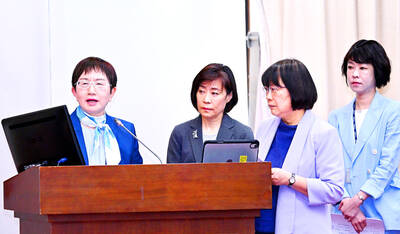The unemployment rate fell to its lowest level in five-and-a-half-years last month, as more first-time jobseekers landed jobs, which helped lift the number of the employed, the Directorate-General of Budget, Accounting and Statistics (DGBAS) said yesterday.
The jobless rate improved to 4.02 percent last month, down 0.06 percentage points from 4.08 percent in December last year, DGBAS said in its monthly report.
That is the lowest level since June 2008.
The seasonally adjusted unemployment rate also dropped 0.07 percentage points to 4.14 percent last month from 4.21 percent in December, the report said.
“The unemployment rate has improved to the level before the global financial crisis struck the nation’s economy and labor market in late 2008,” DGBAS Deputy Director Lo Yi-ling (羅怡玲) told a press conference in Taipei.
There were 462,000 people unemployed last month, a drop of 7,000 from the previous month, the report’s data showed.
The number of first-time jobseekers who failed to get an offer declined by 6,000 last month from December last year, reflecting a recent improvement in the youth market.
The jobless rate for the 15-to-24 age group decreased to 12.69 percent last month, from 13.1 percent the previous month, a fifth straight month of decline, the agency’s statistics showed.
However, there was only a slight rise in the number of employed last month — to 11.04 million — up 7,000 from a month earlier, as the economy’s soft expansion could not provide strong enough momentum for the job market, Lo added.
The number of the unemployed may increase this month given historical trends, as many people looking to change jobs quit before the Lunar New Year holiday, he said.
The agency said real monthly salaries averaged NT$44,739 last year after taking inflation into account, less than the NT$44,798 recorded in 1998, an indication that salaried workers may feel they are earning less than they were 15 years ago.
The average monthly wage in the industrial and service sectors climbed to a new high of NT$37,716 last month, an increase of 0.99 percent from a year earlier, the DGBAS report said.
The overall average monthly wage, including bonuses and compensation, rose 0.17 percent to a new high of NT$45,965 last year compared with 2012, the report said.
However, after adjusting for inflation — which climbed 0.79 percent year-on-year last year — the real average wage, including bonuses and compensation, fell 0.62 percent from 2012 to NT$44,739 per month, the report showed.

‘SWASTICAR’: Tesla CEO Elon Musk’s close association with Donald Trump has prompted opponents to brand him a ‘Nazi’ and resulted in a dramatic drop in sales Demonstrators descended on Tesla Inc dealerships across the US, and in Europe and Canada on Saturday to protest company chief Elon Musk, who has amassed extraordinary power as a top adviser to US President Donald Trump. Waving signs with messages such as “Musk is stealing our money” and “Reclaim our country,” the protests largely took place peacefully following fiery episodes of vandalism on Tesla vehicles, dealerships and other facilities in recent weeks that US officials have denounced as terrorism. Hundreds rallied on Saturday outside the Tesla dealership in Manhattan. Some blasted Musk, the world’s richest man, while others demanded the shuttering of his

ADVERSARIES: The new list includes 11 entities in China and one in Taiwan, which is a local branch of Chinese cloud computing firm Inspur Group The US added dozens of entities to a trade blacklist on Tuesday, the US Department of Commerce said, in part to disrupt Beijing’s artificial intelligence (AI) and advanced computing capabilities. The action affects 80 entities from countries including China, the United Arab Emirates and Iran, with the commerce department citing their “activities contrary to US national security and foreign policy.” Those added to the “entity list” are restricted from obtaining US items and technologies without government authorization. “We will not allow adversaries to exploit American technology to bolster their own militaries and threaten American lives,” US Secretary of Commerce Howard Lutnick said. The entities

Minister of Finance Chuang Tsui-yun (莊翠雲) yesterday told lawmakers that she “would not speculate,” but a “response plan” has been prepared in case Taiwan is targeted by US President Donald Trump’s reciprocal tariffs, which are to be announced on Wednesday next week. The Trump administration, including US Secretary of the Treasury Scott Bessent, has said that much of the proposed reciprocal tariffs would focus on the 15 countries that have the highest trade surpluses with the US. Bessent has referred to those countries as the “dirty 15,” but has not named them. Last year, Taiwan’s US$73.9 billion trade surplus with the US

Prices of gasoline and diesel products at domestic gas stations are to fall NT$0.2 and NT$0.1 per liter respectively this week, even though international crude oil prices rose last week, CPC Corp, Taiwan (台灣中油) and Formosa Petrochemical Corp (台塑石化) said yesterday. International crude oil prices continued rising last week, as the US Energy Information Administration reported a larger-than-expected drop in US commercial crude oil inventories, CPC said in a statement. Based on the company’s floating oil price formula, the cost of crude oil rose 2.38 percent last week from a week earlier, it said. News that US President Donald Trump plans a “secondary